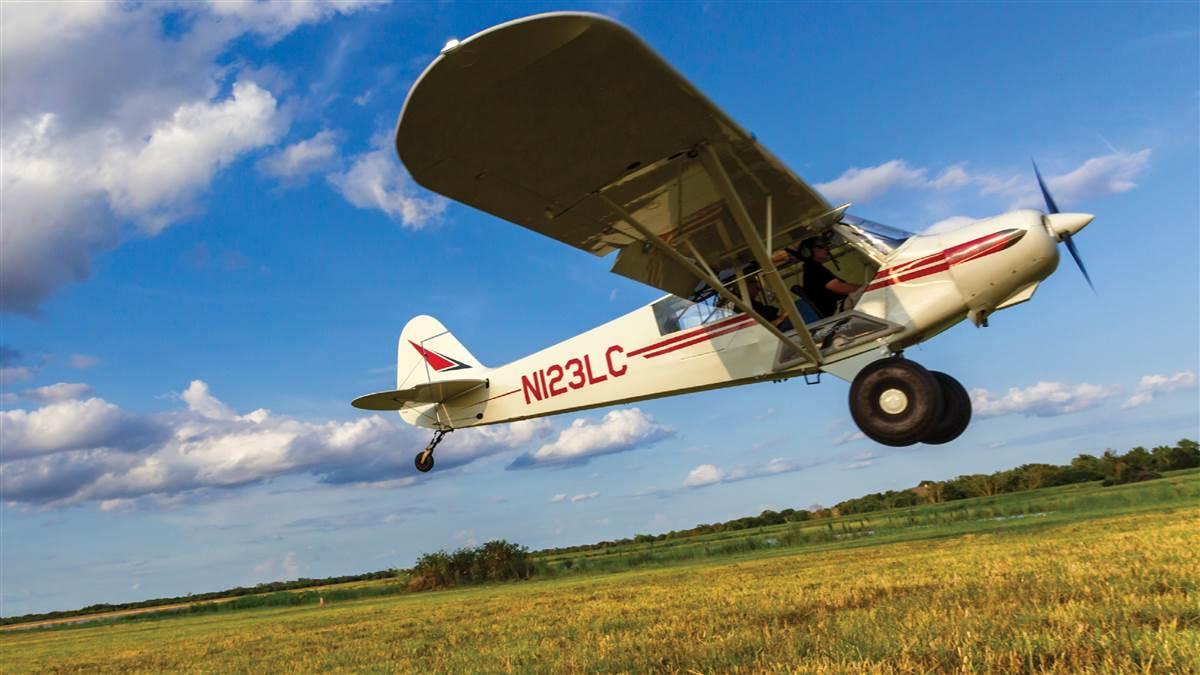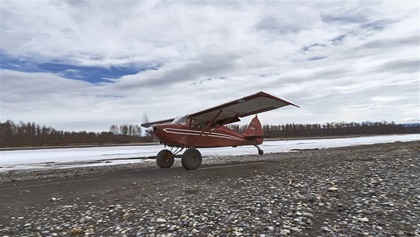Sod season
Tips for soft-field landings

What makes soft-field landings different?
Pilots use soft-field takeoff and landing techniques for rough or soft surfaces such as snow, sand, mud, or tall grass. The FAA’s Airplane Flying Handbook notes that “the approach for the soft-field landing is similar to the normal approach used for operating into long, firm landing areas. The major difference between a normal landing and a soft-field is that during the soft-field landing, the airplane is held 1 to 2 feet off the surface in ground effect as long as possible. This permits a more gradual dissipation of forward speed to allow the wheels to touch down gently at minimum speed. This technique minimizes the noseover forces that suddenly affect the airplane at the moment of touchdown.”
The key here is that the downward energy is managed, and vertical descent velocity is minimized for a soft landing on the main wheels. This makes the landing happen at the lowest possible airspeed in a nose-high position, minimizing the chances the nosewheel will “dig in” or the aircraft will nose over.
Chapter 8 of the Airplane Flying Handbook has some great tips and guidelines that highlight discussion of whether or not to use flaps, whether the aircraft is low- or high-wing, and field conditions. In addition to those, as an instructor I typically highlight a few important considerations.

(Illustration by Kevin Hand)
Technique
The first thing to remember is that you will stop faster on grass and it will take longer distances to take off. Second, you want to keep any pressure off the nosewheel in tricycle-gear aircraft. From there, it becomes a matter of paying attention to any manufacturer recommendations and performance calculations for a soft-field takeoff procedure. With that in mind, each grass runway and condition will offer different performance experiences.
Not all aircraft have published soft-field operations guidelines. In fact, some aircraft aren’t suited to the activity at all. But many are just fine. If you are flying a Cessna 172, Piper Warrior, or many other common general aviation aircraft—even a Cirrus SR22—you may well find that proper technique will enable you to fly to airports you didn’t know you could visit.
Every summer many pilots work to rebuild proficiency for their grassy runway operations after long winter gaps where they were stuck to just the plowed, pavement runways. This is a good way to refresh those skills, and if you aren’t comfortable doing it on your own, don’t be afraid to take someone with you who is. Hiring an instructor familiar with grass runways or dragging along another pilot can help you develop or brush up your soft-field operations skill set.
Local knowledge
I can’t stress this enough: Take advantage of local knowledge.
Grassy runways come in a wide variety. Some are little more than rolled fields; some cross paved runways; some have known wet spots; some have industrious gophers that leave holes periodically. Some are well kept by the local airport management or airport tenants, while others go months between grass cuttings. A few are not even published on charts, and can be great options for days when there are strong crosswinds on the primary runway—but these runways are only of assistance if you know about them before arrival.
If you are thinking about using a grass runway, especially one with which you are not familiar, get more information. Notices to airmen (notams) are a good starting point, if there are any. Frequently there won’t be any notams specifically relating to the grass runways you want to use. When this is the case, make a call.
Calling a local FBO or airport manager can ferret out good information about the current condition of sod runways. Someone who is familiar with the area can share valuable knowledge that you would otherwise have not been able to ascertain.
Conditions
Even if it hasn’t been raining at your home airport, that doesn’t mean the grass runway where you plan to land 100 miles away will be dry and firm. And the fact that it hasn’t rained in the last day doesn’t mean it will be dry, either.
Some grass runways drain less efficiently than others and may take weeks to fully firm up. This can be especially problematic in the spring, when rain in some areas leaves grass runways looking great from the air—but mud may bog down a landing aircraft or foil a takeoff effort.
Check if it’s rained in the area and if there are wet spots on the runway you intend to use. I use a few runways that are good on one end but not the other for much of the year. That may be fine if you have a 5,000-foot grass runway and only need 2,000 feet of it—if you know where the wet spots are—but could be disastrous if you choose the wrong end and don’t know what to avoid.
In addition to wet or muddy runways, you also should avoid runways that have big holes (think gophers), and runways with long grass. All of these conditions will significantly reduce takeoff performance, can allow gear to sink in, or may cause a rather abrupt stop on a landing.
When in doubt
If you can’t get reliable conditions reports, check it out yourself. Landing on another, potentially paved, runway at the airport and checking the grass by walking it can be a good option to get a better feel for the conditions. You could also drive it, with permission from or coordination with the airport operator. Driving a runway in a motor vehicle may help you find potholes or let you know if the weight of a car will leave tracks. If a car, truck, or SUV can travel the runway smoothly without any wet spots or holes, most light GA aircraft will be able to do the same.
 If you don’t have the opportunity to check it out from the ground or are considering landing on a grass runway you didn’t get information about ahead of time, at least fly over it and give it a good look. Once, I saw a seemingly good sod runway in western Illinois along my route home when I was picking up an airplane. Thinking it would be fun to stop at a new field, my wife and I approached the airport for a flyby and noticed an 8-foot hole where someone had been digging for some utility work. Had we been committed to the landing, we might have encountered it about halfway through the rollout.
If you don’t have the opportunity to check it out from the ground or are considering landing on a grass runway you didn’t get information about ahead of time, at least fly over it and give it a good look. Once, I saw a seemingly good sod runway in western Illinois along my route home when I was picking up an airplane. Thinking it would be fun to stop at a new field, my wife and I approached the airport for a flyby and noticed an 8-foot hole where someone had been digging for some utility work. Had we been committed to the landing, we might have encountered it about halfway through the rollout.
A low flyover of the runway at 50 to 100 feet agl can give a pilot one last chance to look over the field conditions. It won’t tell you everything, but it at least can give you an opportunity to see some potential hazards you wouldn’t see from a distance in an approach to landing.
Worst case, best case
If you have doubts—whether in the conditions or your abilities—don’t use the sod. There is no harm done by choosing not to do something that you aren’t comfortable with. A nearby airport and an on-demand car service is always better than an airplane stuck in the mud, or worse.
If you do feel comfortable, enjoy! With the concerns aside or mitigated, grass runways can be a fun option to build new aviation experiences or to visit places that don’t have paved runways. This doesn’t have to mean flying to gravel bars in the remote Alaskan wilderness; it may just mean flying to the grass runway on a resort island with a great restaurant, visiting an airport in a wilderness area where you may go camping for the weekend, or just getting off the beaten path.
Soft-field landings aren’t just something a pilot needs to do on a checkride. For many, landing on soft surfaces is a skill that they can use in the real world. It’s why we learn soft-field landings in the first place. Airport managers and operators spend a significant amount of time every year grooming and preparing grass runways for pilots to use them. Be one of the pilots who makes their efforts worth it.
Jason Blair is a National Association of Flight Instructors master flight instructor and a designated pilot examiner.

 Going beyond
Going beyond

